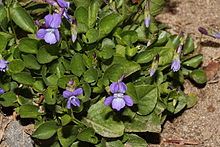| Viola adunca | |
|---|---|

| |
| Conservation status | |
 Secure (NatureServe) | |
| Scientific classification | |
| Kingdom: | Plantae |
| Clade: | Tracheophytes |
| Clade: | Angiosperms |
| Clade: | Eudicots |
| Clade: | Rosids |
| Order: | Malpighiales |
| Family: | Violaceae |
| Genus: | Viola |
| Species: | V. adunca |
| Binomial name | |
| Viola adunca Sm. | |
| Synonyms | |
|
Viola bellidifolia | |
Viola adunca is a species of violet known by the common names hookedspur violet, early blue violet, sand violet, and western dog violet. It is native to meadows and forests of western North America, Canada, and the northern contiguous United States.
Description

This is a hairy, compact plant growing from a small rhizome system. The leaves are spade- or heart-shaped, sometimes with broadly wavy margins. They are generally 0.5 to 4 centimeters long. The single-flowered inflorescence grows at the end of a very thin peduncle reaching about 7.5 cm (3 in) high. The nodding flower is a violet about 1.5 cm (1⁄2 in) long, with five purple petals. The lower three petals have white bases and purple veining. The two side petals are white-bearded near the throat. The upper two petals may have hooked spurs at their tips. It is a perennial blooming in late spring.
There are several varieties of V. adunca; a white-petaled form has been noted in Yosemite National Park.
It has also been observed in Southern Ontario in tall grass prairies on the sand plain and in black oak savannas.
Ecology
Viola adunca is the larval host plant of Myrtle's silverspot. Bees and other insects pollinate it. Polites mardon uses it as a nectar source, and birds and mice use the seed as a food source.
Conservation status in the United States
The species is listed as endangered in Massachusetts and in Connecticut.
Uses
The leaves and flowers are edible, and can be eaten in salads, as potherbs, or brewed as tea. These plant parts are high in vitamins A and C. However, the rhizomes, fruit, and seeds are poisonous to humans and can cause upset stomach, intestinal problems, respiratory and circulatory depression.
Native American ethnobotany
The Blackfoot apply an infusion of the roots and leaves to sore and swollen joints, give an infusion of the leaves and roots to asthmatic children, and use the plant to dye their arrows blue. The Dakelh take a decoction of the entire plant for stomach pain, the Klallam apply a poultice of smashed flowers to the chest or side for pain, the Makah chew the roots and leaves while giving birth, and the Tolowa apply a poultice of chewed leaves to sore eyes.
References
- Sullivan, Steven. K. (2015). "Viola adunca". Wildflower Search. Retrieved 2015-04-23.
- ^ NRCS. "Viola adunca". PLANTS Database. United States Department of Agriculture (USDA). Retrieved 9 December 2017.
- ^ Taylor, Ronald J. (1994) . Sagebrush Country: A Wildflower Sanctuary (rev. ed.). Missoula, MT: Mountain Press Pub. Co. p. 168. ISBN 0-87842-280-3. OCLC 25708726.
- Klinkenberg, Brian, ed. (2014). "Viola adunca". E-Flora BC: Electronic Atlas of the Plants of British Columbia . Lab for Advanced Spatial Analysis, Department of Geography, University of British Columbia, Vancouver. Retrieved 2015-04-23.
- Giblin, David, ed. (2015). "Viola adunca". WTU Herbarium Image Collection. Burke Museum, University of Washington. Retrieved 2015-04-23.
- "Viola adunca". Jepson Flora Project: Jepson Interchange. Jepson Herbarium; University of California, Berkeley. 1993. Retrieved 2015-04-23.
- ^ "USDA Plants Database" (PDF). Plants.usda.gov. Retrieved 29 March 2022.
- "Center for Environmental Inquiry at Sonoma State University".
- "Connecticut's Endangered, Threatened and Special Concern Species 2015". State of Connecticut Department of Energy and Environmental Protection Bureau of Natural Resources. Retrieved 2 January 2017. (Note: This list is newer than the one used by plants.usda.gov and is more up-to-date.)
- Hellson, John C., 1974, Ethnobotany of the Blackfoot Indians, Ottawa. National Museums of Canada. Mercury Series, page 79
- Hellson, John C., 1974, Ethnobotany of the Blackfoot Indians, Ottawa. National Museums of Canada. Mercury Series, page 74
- Hellson, John C., 1974, Ethnobotany of the Blackfoot Indians, Ottawa. National Museums of Canada. Mercury Series, page 123
- Smith, Harlan I., 1929, Materia Medica of the Bella Coola and Neighboring Tribes of British Columbia, National Museum of Canada Bulletin 56:47-68, page 60
- ^ Gunther, Erna, 1973, Ethnobotany of Western Washington, Seattle. University of Washington Press. Revised edition, page 40
- Baker, Marc A., 1981, The Ethnobotany of the Yurok, Tolowa and Karok Indians of Northwest California, Humboldt State University, M.A. Thesis, page 62
External links
 Media related to Viola adunca at Wikimedia Commons
Media related to Viola adunca at Wikimedia Commons- Viola adunca in the CalPhotos photo database, University of California, Berkeley
| Taxon identifiers | |
|---|---|
| Viola adunca |
|